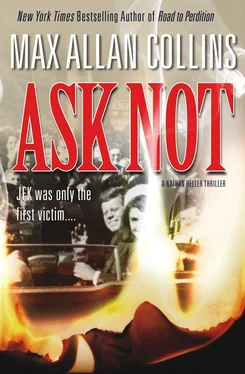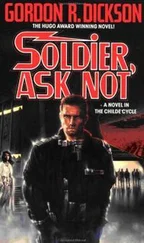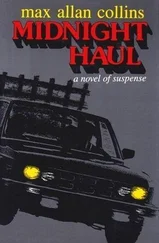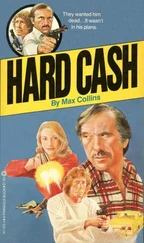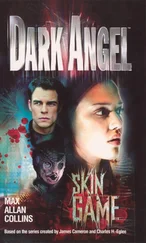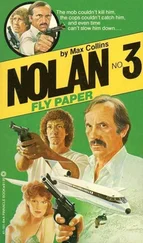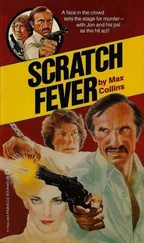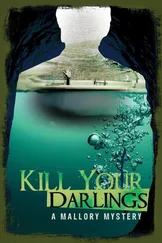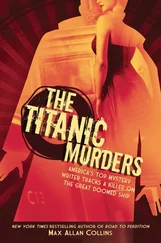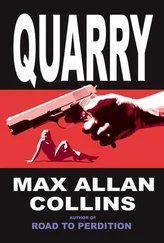He leaned forward and his eyes moved from Flo to me.
He said, “I didn’t know it at the time, but it was Oswald, or somebody who looked a hell of a lot like him. I tried to cross Elm Street to stop them — the two of ’em were obviously in a hurry, and were the only people not running to the scene. That’s human nature when there’s a shooting or an accident, you know, go check out the scene. But they were heading away, so I immediately tried to cross the street, to take the two into custody. Only traffic was too heavy by now, and I couldn’t get to them before they drove off, going west on Elm.”
“You reported this?”
“You bet. Right away I brought it to the attention of the authorities at the command post at Elm and Houston, in front of the book depository. I told a Secret Service agent, or at least that’s how he identified himself, what I’d seen. He didn’t seem too interested. Sheriff Decker himself heard this exchange, and yanked me to one side and told me the suspect had already left the scene. That’s when I got pulled in on what was the first real search of the depository.”
“Decker led that?”
“No. He left that to me and a couple of other deputies. We went up to the sixth floor, which was very dark and dusty. The south side of the building seemed the logical place to start. Immediately we found three spent rifle shells that struck me as arranged, deliberately placed there, in plain sight on the floor by the window. A small brown paper lunch bag with some chicken bones in it was on the floor, too. I called across the room for Dallas Police ID man, Lieutenant Day, to bring his camera over, which he did. Then we started searching the rest of the floor.”
“The rifle hadn’t been found yet?”
He shook his head. “No. We did find it, but that’s a... story in itself.”
“Oh?”
He was nodding as he sipped Coke again, and for the first time he smiled, a small odd smile that didn’t last. “We neared the northwest corner of the floor when a deputy called out, ‘Here it is.’ I went over. Two rows of boxes were stacked close, but when you looked down between them, there it was, on the floor — a rifle on a strap with a telescopic sight, with the bolt facing upward. Lieutenant Day came over and so did Captain Fritz of Homicide. Day retrieved the rifle, activated the bolt, ejected one live round of ammunition. Day inspected the rifle briefly, then handed it to Fritz, who held it up by the strap and asked if anybody knew what kind of rifle it was. Deputy Weitzman, who knew a lot about weapons, used to run a sporting goods store, gave it a close look and said it was a 7.65 German Mauser.”
“What?” I said, sitting up. “Not Oswald’s famous piece-of-shit Mannlicher-Carcano?”
He shook his head. “No. A Mauser.”
“You’re saying at some point a switch was made?”
“I’m saying a deputy who knew his stuff said it was a Mauser, and a bunch of other law-enforcement officers agreed with him. Right about then, word of Officer Tippit’s shooting came in, and it was chaos again.”
He sighed and the waitress came over and asked if he’d like a refill. He looked up at her, nodded and smiled, his second of the afternoon; she smiled back — yes, he was handsome, all right.
I said, “That’s a hell of a story, Deputy Craig.”
“Oh, there’s more. As the afternoon went on, and information came in, and Oswald was arrested at the Texas Theatre, I became convinced that I had seen the assassin and his driver making their getaway from the scene in that Rambler. They would only have to drive six blocks west on Elm and they’d have been on Beckley Avenue, with a straight shot to Oswald’s rooming house. That might have given Oswald time to kill Tippit, which the official story really doesn’t — him taking a bus, getting stuck in traffic, getting off, catching a cab, and so on.”
“Did you ID Oswald as the guy picked up by the station wagon?”
He nodded and another smile emerged, briefly. “I did. Later that afternoon, I called Captain Fritz at the PD and gave him the description of the guy I saw, who Fritz said sounded like their suspect. He asked me to come take a look at him. I got to Fritz’s office a little after 4:30, was given a peek through the door at Oswald, sitting there by Fritz’s desk.”
Flo was watching and listening with the rapt attention you might give a Hitchcock thriller.
Craig continued: “I made the ID, and Fritz and I went in together. He told Oswald, ‘This officer saw you leave the crime scene,’ and Oswald, real defensive and sullen, said that he’d already told them that. Fritz then said, ‘He saw a Latin fella pick you up in a station wagon,’ and Oswald replied, leaning forward on Fritz’s desk, forceful as hell, ‘That station wagon belongs to Mrs. Paine’... who was apparently a friend of his wife’s, and he didn’t want to see her ‘dragged into this.’ Oswald seemed disgusted, like he’d been let down or even betrayed, and Fritz was sort of playing ‘good cop,’ because he almost seemed like he was consoling Oswald, who said, real depressed, ‘Now everybody will know who I am.’”
That sounded to me like an undercover agent whose cover had been blown.
“Miss Kilgore,” he said, sitting forward, firm but pleasant, “I will be glad to cooperate with you any way I can. This has smelled like a cover-up to me since the day it happened, and because I have refused to be part of it, my career has hit a dead end. I expect any day to be fired over one trumped-up thing or another. Just four years ago, I was named Officer of the Year. I nailed an international jewel thief. Do you know that? Officer of the Year.”
His voice was steady, but his eyes were moist.
Beyond the Dealey Plaza underpass — through which an assassinated president had been whisked away into history books that would one day be boxed and stacked in the nearby depository — stretched the city-within-the-city known as Oak Cliff. The boardinghouse where Lee Harvey Oswald had roomed, and the street where he possibly shot J. D. Tippit, and the movie theater where he was arrested, were all in Oak Cliff.
Two hundred seventy-five thousand of Dallas’s citizens also lived there, in the small, older homes close to downtown, and newer houses and apartments farther out. Chiefly a blue-collar community, with considerable natural beauty — in particular the woods and hills of Kessler Park — Oak Cliff was convenient for those working downtown. Young men on their way up would have a home in Oak Cliff only temporarily, relocating their families to more status-friendly North Dallas when raises allowed.
On a quiet side street in Oak Cliff’s newer section lived a young woman who was not on her way up, having already realized her dreams. Most likely she owned the modern six-room bungalow. Unlike much of Texas, the oak tree in her modest front yard realized this was autumn and was spilling leaves. A knock at an antique oval front door quickly summoned the lady of the house, petite, curvy, in her thirties, with a pixie-ish reddish-brown hairdo. Her prettiness was on the pixie side, too, heart-shaped face, wide-set brown eyes, pert nose, and dimpling smile.
“Well, look who’s on my doorstep,” our hostess said, in a lazy, Scarlett O’Hara — ish way. She looked primly festive in a brown-and-orange flower-print cotton dress with flounce sleeves and a full skirt. “Why, when I heard Flo Kilgore wanted to chat with me, I was simply flabbergasted. Come in, come in.”
We did, into a living room arrayed with Early American antiques. Only a few framed family photos on one wall — our hostess with two young boys at various ages — were indicative of this century. She had apparently cleaned the room to perfection, knowing a TV star was coming by.
Читать дальше
